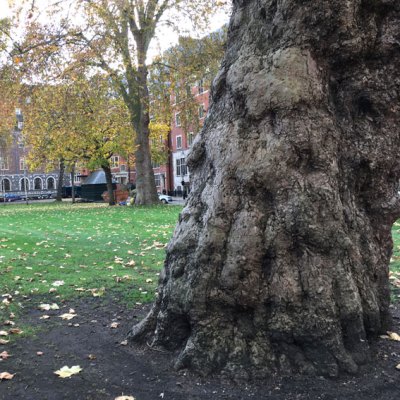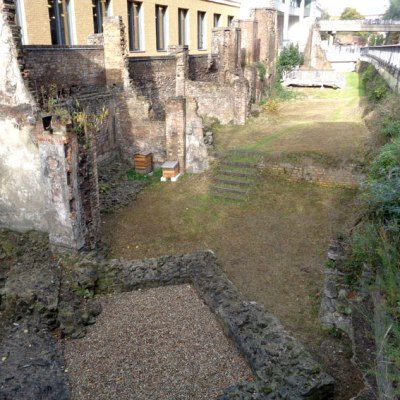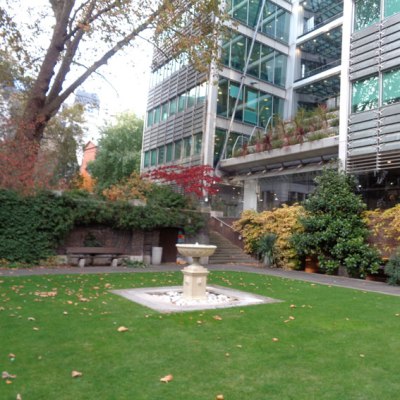Tranquility and Sanctuary and keeping off the grass. (Wednesday 16 November 2016)
Away from the tumult around Parliament Square and the Westminster tourist hubbub and forests of selfie sticks, push past packs of tour groups flocking The Sanctuary, then through the Deans Yard arch and gatehouse. Phew! Step back in time into this tranquil collegiate acre of lawn and mature trees. I slowly walk the lane around this ancient square, past a mixed collection of dignified buildings, dating from Tudor to Georgian, Victorian and prewar, pressed together like a well- thumbed collection of leather bound volumes around the walls of a hushed library. The north and east side are some of the oldest. They house abbey offices and parts of Westminster School. On the south is the majestic Church House, which is the headquarters of the Church of England. And the buildings on west side  contain Westminster Abbey Choir School (founded in 1560, and still educating the 35 or so choirboys, aged 8 – 13, who sing in the Abbey). I walk under its oriel windows and the lilting and piping notes of flute and piccolo spill from an upstairs music classroom; a calming counter to the hoots and toots of relentless traffic beyond this square. There are 10 original Victorian iron lamp standards at intervals around the square. I try to imagine their weak greenish gas glow filtering through the thick smogs of 100 years ago.
contain Westminster Abbey Choir School (founded in 1560, and still educating the 35 or so choirboys, aged 8 – 13, who sing in the Abbey). I walk under its oriel windows and the lilting and piping notes of flute and piccolo spill from an upstairs music classroom; a calming counter to the hoots and toots of relentless traffic beyond this square. There are 10 original Victorian iron lamp standards at intervals around the square. I try to imagine their weak greenish gas glow filtering through the thick smogs of 100 years ago.
The land that is now Westminster was once a teardrop shaped island of about 660 acres, called Thorn Ey (later Thorney Island), where branches of the River Tyburn (now underground in conduits and sewers) flowed into the Thames. Wild, inhospitable and overgrown (hence ‘Thorney’). A small Benedictine monastery was founded here in the early 900s. The land was laboriously tamed and cleared by the monks so that it became one of the most fertile and productive pieces of land in London, with fields, orchards and gardens. Deans Yard is roughly where the monastery farmyard was shaded by an elm tree grove (which gave this part of the monastery it’s popular name ‘The Elms’). In the 11th century Edward the Confessor built the original Westminster Abbey on adjacent land and his Palace of Westminster close  by. Two hundred years later, Henry III rebuilt most of the abbey in the new, elegant Gothic style, housing a shrine to the canonised Edward the Confessor. Over the centuries, many additions and changes were made; the twin western towers being finally completed in 1745.
by. Two hundred years later, Henry III rebuilt most of the abbey in the new, elegant Gothic style, housing a shrine to the canonised Edward the Confessor. Over the centuries, many additions and changes were made; the twin western towers being finally completed in 1745.
I pause at the far end in the shade of Church House and look back across the lawn; swathes and scatters of leaves garnish the mowed stripes. There, rising above, are the magnificent towers. The Portland stone ethereal and gilded in the sunlight. Almost vanishing behind the canopies of plane and chestnut: hanging veils of crumpled gold. A birch tree is a slender, sinewy, pale blue pillar. A plump crow picks the ground around its base, hunting worms. I put my rucksack down on the kerb edge of the lawn (a nearby sign reads ‘PLEASE KEEP OFF THE GRASS’), and set up my easel. Uniformed Westminster School students walk between lessons. They traditionally refer to this space as ‘Green’. I overhear odd snippets of teenage conversation: “…go on, just put your tongue behind it and pull!..” and “..hmm, not a bad film, I rate it approximately 6.75 out of 10…”. A couple of hurrying boys take a shortcut across the grass.
 Westminster school is one of the UK’s most esteemed public schools but has its origins as a small charity school provided by the abbey’s Benedictine monks in the 12th century. Following the Dissolution of the monasteries in the 1540s, the school was allowed to continue. Today there are about 750 pupils from age 7 to 18 (mostly boys, although girls are admitted into the 6th form at 16). Traditionally they have the right to play football on Green.
Westminster school is one of the UK’s most esteemed public schools but has its origins as a small charity school provided by the abbey’s Benedictine monks in the 12th century. Following the Dissolution of the monasteries in the 1540s, the school was allowed to continue. Today there are about 750 pupils from age 7 to 18 (mostly boys, although girls are admitted into the 6th form at 16). Traditionally they have the right to play football on Green.
Until the 17th century, pupils at the school had to share this space with a changing community of dangerous criminals and villains, who took advantage of ‘ecclesiastical sanctuary‘, which traditionally offered immunity from arrest within the abbey precincts. The area in front of the abbey is still called The Sanctuary, but I wouldn’t advise running here after robbing a bank and hoping you’ll be safe, you’re 400 years too late!
Today’s shifting sunlight dramatically changes the mood of the abbey towers; one moment they seem to dissolve into luminescence; then a shadow passes over. Bringing weight and solemnity.
 Behind me, a burst of sudden laughter and the sound of shoes clacking on the raised paved terrace of Church House and down the steps. Some pause to look at my drawing and one tells me she can’t even draw a straight line. I say I can’t either. They’re delegates taking a break from a local government conference being held today. Church House was originally built in 1887 to celebrate Queen Victoria’s Golden Jubilee and intended as a central meeting and administrative building for the Church of England. It was redesigned by architect, Sir Herbert Baker to provide more space and was completed in 1940. Only a year later it took a direct hit during the Blitz, but suffered very little damage. For this reason it was requisitioned to serve as a more secure, wartime Houses of Parliament. After the war, in January 1946, the newly created United Nations Security Council met for the first time in this building. Today it houses various departments of the Church of England, and hosts the annual General Synod meetings. It is also a prestigious venue for all kinds of events, from conferences to weddings.
Behind me, a burst of sudden laughter and the sound of shoes clacking on the raised paved terrace of Church House and down the steps. Some pause to look at my drawing and one tells me she can’t even draw a straight line. I say I can’t either. They’re delegates taking a break from a local government conference being held today. Church House was originally built in 1887 to celebrate Queen Victoria’s Golden Jubilee and intended as a central meeting and administrative building for the Church of England. It was redesigned by architect, Sir Herbert Baker to provide more space and was completed in 1940. Only a year later it took a direct hit during the Blitz, but suffered very little damage. For this reason it was requisitioned to serve as a more secure, wartime Houses of Parliament. After the war, in January 1946, the newly created United Nations Security Council met for the first time in this building. Today it houses various departments of the Church of England, and hosts the annual General Synod meetings. It is also a prestigious venue for all kinds of events, from conferences to weddings.
I close my sketchbook and pack it away. Muffled piano notes float down from the music room window. A leaf lazily twists and gently drifts to earth, exactly in line with the birch tree trunk.
(There are three other original gardens within Westminster Abbey which are free to enter: the Garth, the Little Cloister and College Garden. I’m hoping to return to draw them in early spring.)
In his ‘Sticks in the Smoke’ project, Nick Andrew has been regularly visiting, researching and drawing different publicly accessible parks or gardens in London since January 2016, exploring the theme of city green spaces from the perspective of a rural landscape painter. The first two sketchbooks will be published as a book in late 2018. www.nickandrew.co.uk . Nick is grateful to London Parks & Gardens Trust for their support www.londongardenstrust.org.
Deans Yard, Westminster Abbey, London. SW1P 3NZ
Opening times: 10-4 on Tuesday, Wednesday and Thursday. Free entry
Google earth view here





















